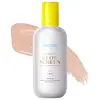Supergoop! Glowscreen Soft-Radiance Drops Mineral SPF 40 Versus hyphen Golden Hour Glow Screen SPF 50
What's inside
What's inside
 Key Ingredients
Key Ingredients

 Benefits
Benefits

 Concerns
Concerns

 Ingredients Side-by-side
Ingredients Side-by-side

Zinc Oxide 15.11%
Cosmetic ColorantWater
Skin ConditioningEthylhexyl Palmitate
EmollientCaprylic/Capric Triglyceride
MaskingPropanediol
SolventDimethicone
EmollientPolyglyceryl-3 Polyricinoleate
EmulsifyingSorbitan Isostearate
EmulsifyingPolyglyceryl-2 Dipolyhydroxystearate
Skin ConditioningFragaria Ananassa Seed Oil
AntioxidantPongamia Pinnata Seed Extract
Skin ConditioningClitoria Ternatea Flower Extract
Skin ConditioningPolyglyceryl-6 Polyricinoleate
EmulsifyingButylene Glycol
HumectantPolyhydroxystearic Acid
EmulsifyingPolysilicone-11
Inulin
Skin ConditioningMagnesium Sulfate
Triethoxycaprylylsilane
Sodium Phytate
Lecithin
EmollientIsopropyl Myristate
EmollientIsostearic Acid
CleansingGluconolactone
Skin ConditioningSodium Benzoate
MaskingCalcium Gluconate
HumectantIron Oxides
Titanium Dioxide
Cosmetic ColorantMica
Cosmetic ColorantZinc Oxide 15.11%, Water, Ethylhexyl Palmitate, Caprylic/Capric Triglyceride, Propanediol, Dimethicone, Polyglyceryl-3 Polyricinoleate, Sorbitan Isostearate, Polyglyceryl-2 Dipolyhydroxystearate, Fragaria Ananassa Seed Oil, Pongamia Pinnata Seed Extract, Clitoria Ternatea Flower Extract, Polyglyceryl-6 Polyricinoleate, Butylene Glycol, Polyhydroxystearic Acid, Polysilicone-11, Inulin, Magnesium Sulfate, Triethoxycaprylylsilane, Sodium Phytate, Lecithin, Isopropyl Myristate, Isostearic Acid, Gluconolactone, Sodium Benzoate, Calcium Gluconate, Iron Oxides, Titanium Dioxide, Mica
Water
Skin ConditioningTerminalia Ferdinandiana Fruit Extract
AntioxidantGlycerin
HumectantIsododecane
EmollientPolymethylsilsesquioxane
Ethylhexyl Methoxycinnamate
UV AbsorberCI 77891
Cosmetic ColorantMica
Cosmetic ColorantButyl Methoxydibenzoylmethane
UV AbsorberAmmonium Acryloyldimethyltaurate/Carboxyethyl Acrylate Crosspolymer
Dimethicone
EmollientPalmitoyl Tripeptide-1
Skin ConditioningPalmitoyl Tetrapeptide-7
Skin ConditioningCitrus Nobilis Fruit Extract
MaskingEctoin
Skin ConditioningCamellia Sinensis Leaf Extract
AntimicrobialCaprylic/Capric Triglyceride
MaskingBis-Ethylhexyloxyphenol Methoxyphenyl Triazine
Skin ConditioningButylene Glycol
HumectantCetearyl Olivate
Phenoxyethanol
PreservativeSynthetic Fluorphlogopite
Sorbitan Olivate
EmulsifyingDiethylhexyl Butamido Triazone
UV AbsorberXylitol
HumectantGlucose
HumectantCI 77491
Cosmetic ColorantTocopheryl Acetate
AntioxidantPhospholipids
Skin ConditioningAnhydroxylitol
HumectantSodium Gluconate
Skin ConditioningThermus Thermophillus Ferment
Skin ConditioningEthylhexylglycerin
Skin ConditioningPhoenix Dactylifera Seed Extract
MoisturisingTin Oxide
AbrasiveCarbomer
Emulsion StabilisingPolysorbate 20
EmulsifyingHydroxymethoxyphenyl Decanone
Skin ConditioningWater, Terminalia Ferdinandiana Fruit Extract, Glycerin, Isododecane, Polymethylsilsesquioxane, Ethylhexyl Methoxycinnamate, CI 77891, Mica, Butyl Methoxydibenzoylmethane, Ammonium Acryloyldimethyltaurate/Carboxyethyl Acrylate Crosspolymer, Dimethicone, Palmitoyl Tripeptide-1, Palmitoyl Tetrapeptide-7, Citrus Nobilis Fruit Extract, Ectoin, Camellia Sinensis Leaf Extract, Caprylic/Capric Triglyceride, Bis-Ethylhexyloxyphenol Methoxyphenyl Triazine, Butylene Glycol, Cetearyl Olivate, Phenoxyethanol, Synthetic Fluorphlogopite, Sorbitan Olivate, Diethylhexyl Butamido Triazone, Xylitol, Glucose, CI 77491, Tocopheryl Acetate, Phospholipids, Anhydroxylitol, Sodium Gluconate, Thermus Thermophillus Ferment, Ethylhexylglycerin, Phoenix Dactylifera Seed Extract, Tin Oxide, Carbomer, Polysorbate 20, Hydroxymethoxyphenyl Decanone
Ingredients Explained
These ingredients are found in both products.
Ingredients higher up in an ingredient list are typically present in a larger amount.
Butylene Glycol (or BG) is used within cosmetic products for a few different reasons:
Overall, Butylene Glycol is a safe and well-rounded ingredient that works well with other ingredients.
Though this ingredient works well with most skin types, some people with sensitive skin may experience a reaction such as allergic rashes, closed comedones, or itchiness.
Learn more about Butylene GlycolThis ingredient is an emollient, solvent, and texture enhancer. It is considered a skin-softener by helping the skin prevent moisture loss.
It helps thicken a product's formula and makes it easier to spread by dissolving clumping compounds.
Caprylic Triglyceride is made by combining glycerin with coconut oil, forming a clear liquid.
While there is an assumption Caprylic Triglyceride can clog pores due to it being derived from coconut oil, there is no research supporting this.
Learn more about Caprylic/Capric TriglycerideDimethicone is a type of synthetic silicone created from natural materials such as quartz.
What it does:
Dimethicone comes in different viscosities:
Depending on the viscosity, dimethicone has different properties.
Ingredients lists don't always show which type is used, so we recommend reaching out to the brand if you have questions about the viscosity.
This ingredient is unlikely to cause irritation because it does not get absorbed into skin. However, people with silicone allergies should be careful about using this ingredient.
Note: Dimethicone may contribute to pilling. This is because it is not oil or water soluble, so pilling may occur when layered with products. When mixed with heavy oils in a formula, the outcome is also quite greasy.
Learn more about DimethiconeMica is a naturally occurring mineral used to add shimmer and color in cosmetics. It can also help improve the texture of a product or give it an opaque, white/silver color.
Serecite is the name for very fine but ragged grains of mica.
This ingredient is often coated with metal oxides like titanium dioxide. Trace amounts of heavy metals may be found in mica, but these metals are not harmful in our personal products.
Mica has been used since prehistoric times throughout the world. Ancient Egyptian, Indian, Greek, Roman, Aztec, and Chinese civilizations have used mica.
Learn more about MicaWater. It's the most common cosmetic ingredient of all. You'll usually see it at the top of ingredient lists, meaning that it makes up the largest part of the product.
So why is it so popular? Water most often acts as a solvent - this means that it helps dissolve other ingredients into the formulation.
You'll also recognize water as that liquid we all need to stay alive. If you see this, drink a glass of water. Stay hydrated!
Learn more about Water